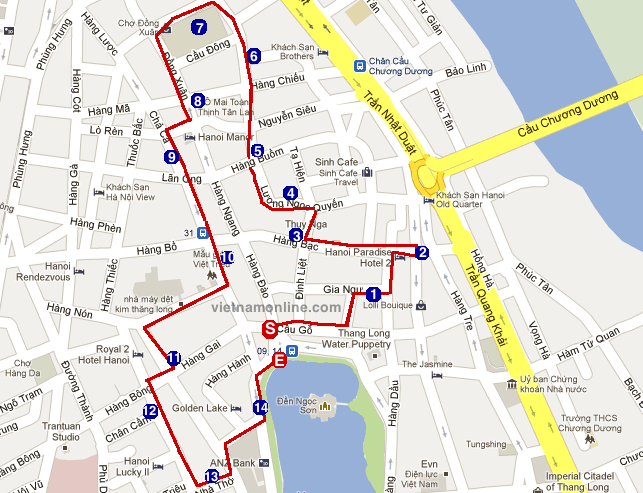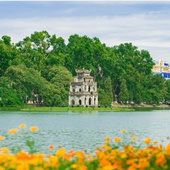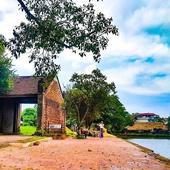A Full Day Walking The Streets of Hanoi Old Quarter
Hanoi’s Old Quarter has a long history of 2000 years of development which is the beating heart old the city.
Hanoi Old Quarter boasts a rich history spanning over 2000 years, serving as the vibrant heart of the city. Here, the lively essence of Hanoians is vividly portrayed through bustling streets filled with traders and shoppers. The quarter consists mainly of the 36 Old Streets, which are aptly named after the various crafts that were historically prominent in the area, many of which continue to thrive today. This locality also embodies the cultural architecture, historic relics, and religious heritage of Hanoi. This guide is crafted to assist tourists in experiencing a comprehensive walking tour of this essential destination.
 A quick map for walking in Hanoi Old Quarter
A quick map for walking in Hanoi Old Quarter
Begin your journey at the start of Cau Go Street, where the renowned Avalon Coffee Lounge is located. After a short walk of about 100 meters, look for a narrow lane on your left that leads to Gia Ngu Street, known for its wide selection of scarves and undergarments in countless styles and colors, along with various clothing stores catering to older adults.
Using the map above, take a right on Gia Ngu to reach Hang Be Market (marked as 1), then cross the street to Nguyen Huu Huan for a delightful bowl of Xoi Xeo (marked as 2) at Xoi Yen restaurant, perfect for people-watching.
From the Xoi Xeo intersection, head to Hang Bac Street and walk straight. Stand mid-way down the street to be dazzled by the glittering gold and silver shops. Consider picking up some unique jewelry as souvenirs for your friends.
Continuing straight ahead from the junction (marked as 3) leads you to Luong Ngoc Quyen Street — a hub filled with snack stalls offering various traditional cakes such as Banh Day, Banh Gio, and Banh Chin Tang May. This intersection buzzes with activity all year round, attracting crowds who often enjoy sitting and drinking beer. You might even make new friends here in the afternoons!
Proceeding past Luong Ngoc Quyen, you will find the 208-meter-long Hang Giay Street which sells the Vietnamese specialty “Thit Bo Kho” (Dried spiced beef) along with a variety of pottery items.
The next stop is Hang Buom Street, which played a significant role during the resistance against the French colonists, serving as a thriving trade center. Today, the street retains its historic charm with numerous grocery and wine shops. Be sure to visit the ancient Bach Ma Temple (marked as 5), located at 76 Hang Buom, one of the Four Protectors of Thang Long.
After exploring Hang Buom Street, return to the junction with Hang Giay and continue until you reach Hang Chieu Street. Turn right to witness one of the 21 gates of Thang Long: O Quan Chuong (Quan Chuong Gate). Despite the ravages of time, the gate still retains its original form, featuring one main arch and two smaller sides.
Another must-visit spot is Dong Xuan Market, accessible via its main gate on Dong Xuan Street (marked 6 and 7). You can also enter the bustling market through Cau Dong or Hang Khoai Street, both just a short stroll from your last stop. Established in the early 20th century, it is now Hanoi’s largest wholesale market, offering a diverse array of goods, from electronics and silk to fresh produce. Notably, the market transforms into a street food haven in the evenings, providing an authentic taste of Hanoi’s culinary delights.
Exiting Dong Xuan Market through its main gate on Dong Xuan Street, turn right and continue to Hang Duong Street, famous for its dried sweetened fruits and vegetables known as “ô mai” and “mứt” (marked as 8). On this vibrant street, visit Cau Dong Pagoda, constructed in the 17th century, which honors Prime Minister Tran Thu Do, significant in establishing the Tran Dynasty (1225-1400).
Navigate past a small alley named Hang Ca to reach the renowned Cha Ca Street. The street is famous for its signature dish, “Cha Ca”, and you must try it at Cha Ca La Vong, located at number 14 (marked as 9 on the map), which is widely regarded as the birthplace of this celebrated dish.
After enjoying your meal, continue along to Lan Ong Street, where the aroma of traditional pharmaceuticals fills the air, and proceed until you reach Hang Can Street. Follow this path to get to Luong Van Can Street (marked 10); go to the end of this street and take a right to discover Hang Gai Street – a paradise for silk enthusiasts featuring exquisite scarves, finely tailored garments, and elaborately embroidered evening wear and handbags.
It takes approximately 5 minutes to reach Ly Quoc Su Street, located just off Hang Gai. This street is home to numerous clothing shops and is the site of the Ly Quoc Su Temple, built in 1131 during the Ly Dynasty, showcasing impressive ancient architecture. The end of this street leads to the awe-inspiring Saint Joseph Cathedral, located at 40 Nha Chung Street, where regular religious services are conducted for the Christian community. The cathedral was constructed in 1882 and exemplifies Gothic architecture, preserving its historical beauty.
Turn right at the first lane you encounter to reach Le Thai To Street, which borders the famous Hoan Kiem Lake. A stroll around the lakeside is highly recommended for memorable photographs against the backdrop of the tranquil waters. If you’re fortunate, you might catch a glimpse of the legendary turtle surfacing.
Completing your tour at the fountain on Dinh Tien Hoang Street signifies the end of this walking expedition. While some streets such as Hang Ngang, Hang Dao, or Hang Ma may remain unexplored, it is suggested to save them for an evening adventure. Hanoi truly comes alive at night on these streets, with vibrant street food vendors and souvenir stands illuminated by twinkling red lanterns on Hang Ma Street.
More:

Hanoi In 3 Days - Things To Do And See
A suggested itinerary for travelers spending about 3 days in Hanoi.

Hanoi Essentials In One Day
Want to see the essence of Hanoi in 1 day - here we tell you how.

Hanoi Traditional Village Tours
Why don’t we just open the latest version of Hanoi map, rent a motorbike or catch a bus to go a little further to the outskirts of Hanoi, where there are many beautiful traditional villages still waiting for you to come and spend your day in the most meaningful way?








